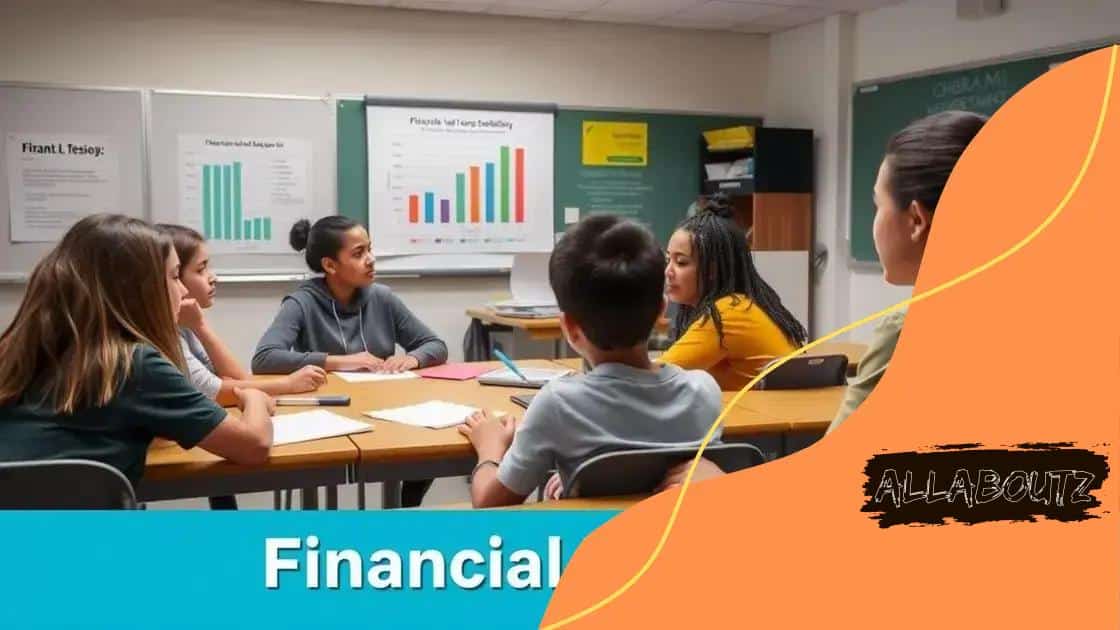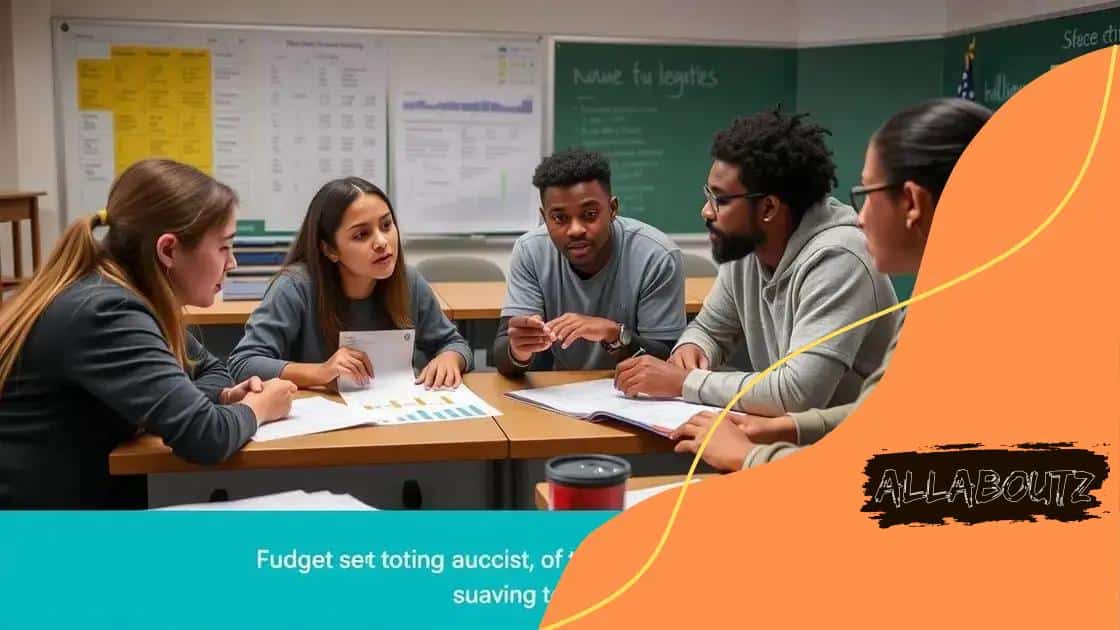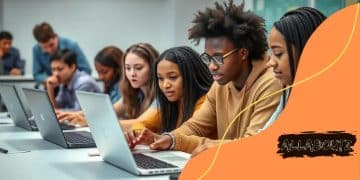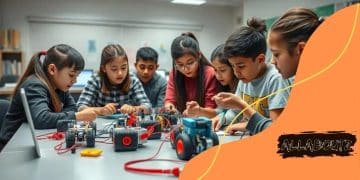Financial literacy programs integrated into school curriculums

Integrating financial literacy programs into school curriculums equips students with essential money management skills, enabling them to make informed financial decisions and fostering long-term financial stability.
Financial literacy programs integrated into school curriculums are becoming increasingly vital as young people face complex financial decisions. Have you ever wondered how these programs could shape their future? Let’s dive into the potential benefits and practical steps for integration.
The importance of financial literacy in education
Understanding money is crucial for everyone, especially young people. Financial literacy goes beyond basic math; it equips students with vital skills. By learning about finances early, students can make informed decisions in their adulthood.
Why Financial Literacy Matters
When students grasp financial concepts, they are more likely to:
- Make wise spending choices.
- Save for future goals.
- Avoid debt pitfalls.
- Invest wisely to grow their wealth.
The role of financial literacy in education cannot be overstated. It provides tools that help young individuals navigate the complexities of personal finance.
Real-World Applications
For instance, educators can teach budgeting through hands-on projects. Students might create a budget for a hypothetical event, considering expenses like food, decorations, and permissions. This method makes learning engaging and relevant.
Additionally, discussing real-life scenarios helps students relate. For example, talking about student loans or credit cards can spark their interest in understanding how these impact their financial futures. The earlier they learn about these topics, the better prepared they’ll be.
Building Confidence
Moreover, when students learn about money management, they gain confidence in their abilities. They may feel more empowered to ask questions about finances, whether at home or in a community. This confidence can lead to a shift in how their peers view money.
As schools emphasize the importance of financial literacy, students become proactive. They start to take charge of their own financial education by seeking further knowledge independently.
Key components of effective programs
To foster financial literacy, effective programs must include essential components. These elements help ensure that students learn valuable skills that last a lifetime.
Interactive Learning
One key component is interactive learning. Students engage more when they participate in activities rather than just listening to lectures. For example, simulations of real-life financial situations can make the lessons more appealing.
- Hands-on projects.
- Group discussions.
- Real-life case studies.
When students work together, they learn from each other and build confidence in their financial abilities.
Personalized Curriculum
Another important aspect is a personalized curriculum. Not every student learns the same way. A curriculum that adapts to different learning styles can be especially effective. This approach allows students to engage with the content at their own pace.
Programs should incorporate a variety of resources, such as videos, online modules, and guided practice. This variety ensures that every student finds a method that resonates with them.
Expert Instructors
Moreover, having knowledgeable instructors is crucial. Teachers need not just financial knowledge but also the ability to connect with students. They should inspire and challenge students, fostering a supportive environment.
Furthermore, inviting guest speakers from the financial industry can enhance the learning experience. Hearing real-world experiences can motivate students to take their learning seriously.
Assessment and Feedback
Assessment is vital in an effective program as well. Regular evaluations help gauge student understanding. They should not only focus on grades but also provide constructive feedback.
- Quizzes and tests.
- Group projects.
- Self-assessments.
This ongoing feedback allows students to track their progress and make necessary adjustments along the way.
Impact on students’ future financial decisions

The impact of financial literacy programs on students’ future financial decisions is profound. When students learn essential financial skills, they are better equipped to handle real-life situations.
Better Spending Habits
By understanding how to budget and save, students can develop better spending habits. They learn to prioritize needs over wants. This skill helps them avoid impulsive purchases and manage their money wisely.
- Setting realistic budgets.
- Tracking expenses effectively.
- Identifying needs versus wants.
These habits create a solid foundation for future financial responsibility.
Informed Decision-Making
Another key impact is informed decision-making. Financial literacy equips students with knowledge about loans, credit, and investments. With this knowledge, they can evaluate their options more critically.
For instance, understanding interest rates helps them choose better loan terms. This awareness empowers students to make decisions that align with their long-term financial goals.
Avoiding Debt Traps
Moreover, students who participate in financial literacy programs are less likely to fall into debt traps. They learn about the dangers of high-interest loans and credit card debt early on. This knowledge enables them to navigate financial products with caution.
Instead of overspending, they focus on saving for emergencies and future investments, which is key to building wealth.
Long-Term Financial Security
Ultimately, the skills learned in these programs contribute to long-term financial security. Students are more likely to save for retirement and understand the importance of investing. This proactive approach leads to a more stable financial future.
- Understanding different investment options.
- Planning for retirement early.
- Assessing financial risks.
Since they begin learning at a young age, their confidence and competence grow over time, paving the way for a healthy relationship with money.
Case studies of successful implementations
Examining case studies of successful implementations of financial literacy programs provides valuable insights. These examples demonstrate how schools can effectively teach students essential money management skills.
Example 1: Local High School Initiative
At a local high school, teachers integrated financial literacy into the existing curriculum. They created a course that covered topics like budgeting, saving, and investing. Students participated in hands-on activities, such as creating personal budgets.
- Engaged in interactive simulations.
- Learned from guest speakers in finance.
- Collaborated on group projects around real-life scenarios.
This initiative led to a noticeable improvement in students’ understanding of personal finance, with surveys showing increased confidence in managing their own money.
Example 2: Community Partnership Program
Another successful model involved a partnership between a school and a local bank. This program provided resources and expert instructors to teach financial literacy.
Students not only learned essential concepts but also applied their knowledge in practical ways. For instance, they took field trips to the bank, where they observed how to open accounts and save money effectively.
Interviews with students revealed their excitement about learning and how they planned to apply this knowledge in their future lives. This collaboration also fostered a sense of community between the school and local businesses.
Example 3: Online Learning Platform
One school district implemented an online learning platform focused on financial literacy. This platform offered courses ranging from basic budgeting to advanced investment strategies. Students could learn at their own pace, which was especially helpful during challenging times.
- Accessed a variety of learning materials.
- Participated in virtual discussions and forums.
- Received personalized feedback from instructors.
This flexibility allowed more students to engage in financial literacy, leading to higher enrollments and improved learning outcomes.
Each of these case studies highlights the importance of adapting financial literacy programs to fit different educational environments. Through creativity and collaboration, schools can successfully equip their students with essential financial skills for the future.
How schools can overcome challenges in adopting programs
Schools face various challenges when adopting financial literacy programs. However, with the right strategies, these obstacles can be overcome effectively.
Engaging Stakeholders
One major challenge is gaining support from all stakeholders. This includes teachers, parents, and school administrators. Engaging them early in the process is crucial. Schools can benefit from hosting information sessions that explain the program’s importance.
- Highlight success stories from other schools.
- Provide data on the long-term benefits of financial literacy.
- Encourage parents to participate in discussions.
When everyone understands the value of the program, they are more likely to contribute positively.
Training Teachers
Another challenge lies in ensuring that teachers are adequately trained. Many educators may not feel comfortable teaching financial subjects. Schools should invest in professional development focused on financial literacy.
Workshops and online courses can provide teachers with the necessary resources and confidence. Moreover, creating a community of practice where teachers share ideas and best practices can enrich the learning experience.
Integrating into the Curriculum
Integrating sound financial literacy content into existing curriculums can also be difficult. Schools can overcome this by aligning financial education with subjects like math, social studies, and economics. This interdisciplinary approach makes it easier to incorporate financial concepts.
Additionally, adapting lessons to reflect real-world situations can make the content more relatable. For example, using current events related to money management can spark relevant discussions among students.
Accessing Resources
Schools may struggle with accessing adequate resources. Seeking community partnerships with financial institutions or local organizations can provide valuable support. These partnerships may offer guest speakers, materials, and even funding.
- Work with local businesses to provide mentoring.
- Request donations of financial literacy materials.
- Utilize online resources and platforms that offer free lessons.
Through these collaborations, schools can enrich their financial literacy programs and provide students with diverse learning opportunities.
FAQ – Frequently Asked Questions about Financial Literacy Programs
What are financial literacy programs?
Financial literacy programs teach essential money management skills, including budgeting, saving, and investing.
Why are these programs important for students?
They equip students with the knowledge to make informed financial decisions, leading to better long-term financial health.
How can schools overcome challenges in implementing these programs?
Schools can engage stakeholders, train teachers, and form community partnerships to support program adoption.
What impact do financial literacy programs have on students’ future?
These programs lead to better spending habits, informed decision-making, and reduced chances of falling into debt.





